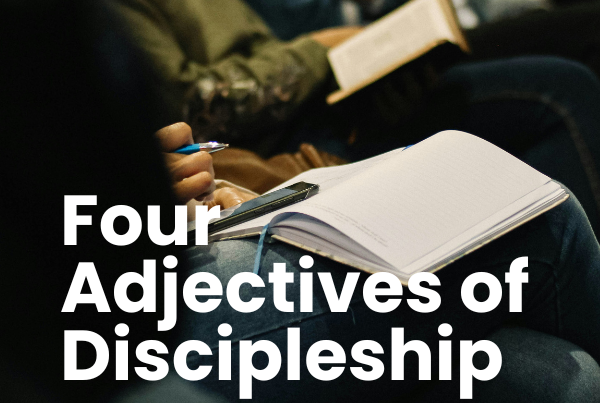
Perhaps you have heard of reluctant missionaries and pioneer missionaries, but have you ever heard of “a kind of missionary?” This was Patrick Collinson’s description of his mother, Belle Patrick, who as a young woman, went to Algiers, North Africa, to assist Lilias Trotter, noted pioneer missionary to Arab & Berber Muslims.
Belle Hay Patrick (1895-1972) was born August 22 in the Scottish fishing community of Anstruther.
She was the eighth of 10 children. Her son, Patrick, wrote, “Belle had more than her fair share of the Patrick brains, although she was not, at first, very practical, in the domestic sense. Her mother sometimes called her a “gey, haundless tottie (a happy but helpless little one).”1 But with her “fair share of brains,” little Belle “learnt the entire book of Psalms by heart and never forgot them.” At the age of nine, she won a scholarship to the local secondary school, which eventually led to a scholarship at St. Andrews University. She qualified as one of the first three women lawyers in Scotland in 1925, but she never practiced. Instead she responded to a call to become a “kind of missionary” in Algeria. In her own words, “It was to be the Gospel instead of the Law.”2
SCOTLAND (1920-1925)
As a young woman, children were drawn to Belle. A prayer meeting that she started with five other friends at the end of World War I, soon began to attract children. Four little girls who had been skipping rope came one August evening to peer through the open windows at the women praying. Belle said to them, “If you want to see what we are doing, come inside. You’ll be less bother in than out,”3 and in they trooped. They sat in a row on the front bench. The women went through their usual routine of hymn-singing, Bible-reading, prayer and an address, and the girls were as quiet as mice. Belle wrote:
“I felt really sorry for them, prisoners of their own choice, in a cold dark room, while outside the sun still shone and other bairns were laughing and playing. So when our service was over I said, ‘You’ve been very good so I’ll tell you a story all to yourselves’, and I launched on my favourite pastime. They were still quite quiet but now it was not the quiet of boredom; they were entranced. When I finished and they reluctantly rose from their seats I said: ‘We’ll be back next week and if you come half an hour earlier I’ll be here to tell you a story and then you can go home without sitting through the meeting.’ Next week I was greeted by eight children, and week by week the numbers grew until I had over fifty, packed like herrings on the narrow benches. Then in walked the halflins, half-grown boys, adolescents. The South fishing had started and all the men and older boys had left, so there was nothing to do in the dead town. So what better than to break up the bairns’ meeting? By changing my style of story-telling I managed to keep them in reasonable control for the children’s meeting, but then they began to stay behind for the women’s prayer meeting!”4
Weeks later, after Belle had told a gangster type story and preached what she thought was a gospel sermon, she decided to confront the boys by appealing to their better nature. “And then a remarkable thing happened. Week by week we had prayed for revival, and now it happened. The boys were held to their seats by a power outside themselves; they were under conviction of sin. Our six lads went home converted.”5 It was the autumn of 1920, and there in East Anglia to the south, the last of the fishermen’s revivals broke out. She wrote, “Many of our local fishermen were caught up in the movement of the Spirit. When the campaign was over our Prayer Union group had grown from 6 to 60. Again I felt a concern for the children. So I started a children’s meeting for them, which met before the prayer meeting, and once again it grew by leaps and bounds until it was difficult to pack all the youngsters into the room. The reading room could hold about 80-100 adults, but on my register I had 200 children, with an average attendance of about 150, and mostly I had no helpers!”6
ALGIERS (1925-1927)
By November 1925 Belle Patrick found herself in Algiers at Dar Naama with beloved artist & missionary Lilias Trotter.
Belle’s son Patrick wrote, “I say ‘a kind of missionary’ since her role was that of secretary to the remarkable Miss Lilias Trotter, founder and leader of the Algiers Mission Band (AMB).” When Belle arrived at Dar Naama, she found Lilias, age 72 with a weakened heart and confined to her bed. Patrick wrote, “She lived with Miss Trotter and others in Dar Naama, the rambling house of a former Barbary corsair (pirate!) in El Biar, Algiers.”7
Her initial missionary posting was for one year. Lilias wrote one enthusiastic letter after another to Belle’s mother; she said, “I do look on her as one of God’s most special gifts to me of late.”8 She explained to Mrs. Patrick that Belle’s first task was in “getting the gospel to the Sufi Moslems, a brotherhood of mystics.” As Lilias saw it, Belle was accomplishing this by typing the text of her book The Way of the Sevenfold Secret, considered by many as Miss Trotter’s magnum opus.
Written with the Sufi brotherhood in mind, it was a book based on the seven I Am’s of Christ in John’s gospel. The next project was a beautifully illustrated oversized book, Between the Desert and the Sea. Miss Trotter had assembled the watercolor illustrations earlier in her confinement, and now she began to prepare the text with the help of her secretary, Belle.9
The intent of the book was to “make people care,” Lilias said.10 “The text reveals her intimate knowledge and love of a people and a land; the watercolours bring to life unforgettable images, exquisite and exotic.”11 In her forward Lilias writes, “The colour pages and the letterpress are with one and the same intent—to make you see. Many things begin with seeing in this world of ours.” 12 Belle saw. When she left Dar Nama for home in 1927, she went with the vision to tell of the ‘other sheep’ that Jesus had in Algiers (John 10:16).
At the end of her first year, Lilias told Belle that she could not see her as a missionary, “at least not yet.”13 Before heading back to the UK, she felt that it was necessary for Belle to learn more about the mission by joining some of the tournées (tours) undertaken in the interior of Algeria and Tunisia, as a colporteur, distributing Christian literature. She wrote to her mother some of her hair-raising adventures in places not yet frequented by tourism. The railway lines were often blocked by drifts of sand. When traveling by car, they were bounced around as shuttlecocks due to the deeply rutted roads, while other times they had to take off their shoes and stockings to pull the car through mud and mire and salt marshes.14
Miss Trotter and her team appointed Belle as assistant secretary of the AMB in London, England. She was to organize prayer groups that were springing up across Britain, and she was to be the “liaison officer” between the field needs and the prayer partners.15 Before Belle left Dar Naama, Miss Trotter had clarified her English and French wills—Belle’s “fair share of brains” and law degree must have been useful. But Lilias’ most personal legacy was her journals and sketchbooks to be distributed among her family and friends, including the contents of ” one hundred & twenty-five pigeon hole shelves and drawers.” Under Miss Trotter’s direction, Belle had organized the ordering of the contents of those pigeon holes into alphabetical order!16
LONDON
Meanwhile, before leaving Algiers, Belle had met a Mr. Cecil Collinson, Deputation Secretary of the AMB. Upon her return to Britain in 1927, “Mr Collinson escorted Belle and another missionary lady to the Keswick Convention in July. It was at the nearby Friars Crag on Derwentwater that he proposed marriage. By the end of the year they were married.”17 Belle later discovered that it had been Mr. Collinson who suggested the placement of Belle in Croydon, South London, as the assistant secretary of the AMB! Perhaps this foreknowledge had also influenced Miss Trotter’s remark to Belle that she could not see her as a missionary, “at least not yet.”
EGYPT
Cecil had retired from business in the 1920s as he felt a call to evangelize the muslim world, now devoting himself full-time to the home end of such missions as the AMB, the North Africa Mission and the Fellowship of Faith for the Muslims. Later in 1935, he was appointed Secretary of the Egypt General Mission (EGM), which led to regular visits to Egypt with Belle. It seems Cecil was a “kind of missionary,” too.
During WWII, the Collinson family lived in Highbury, North London, where their house was badly damaged twice by bombs. Belle & Cecil also ran a canteen for the forces. Cecil died in 1952 and in the 20 years of life remaining, Belle applied her astuteness in all directions. She actually typed Patrick’s Ph.D. thesis, and when he became a lecturer at the University of Khartoum in the SUDAN, Belle spent her winters there with him. Many of her old missionary friends were deployed there, and she took trips with them as challenging as those Algerian tournées 30 years earlier! She moved to Sydney, AUSTRALIA, with Patrick and his family celebrating her 74th birthday en route. In Sydney she was soon doing all the secretarial work for the local office of the Middle East General Mission (formerly EGM). She died of cancer, patiently borne, in January 1972. Belle’s book, Recollections of East Fife Fisher Folk, lay in a drawer unpublished for many years. Upon re-reading her remarkable book before publishing, Patrick remarked, “I think I always underestimated my mother.”
A “kind of missionary?”
Yes, of the very special kind. What was her legacy? Today we like to use the phrase “on mission” and a word derived from two words “mission” and “intentional,” that is “missional,” to describe an active walk of faith. Certainly those modern terms “on mission” and “missional” fit Belle Patrick well. Everywhere she ventured she was herself. She used her upbringing, education, talent, personality and Spiritual gifts, with the intention of bearing the name of Christ and making Him known. Her life spanned 77 years in six different countries. In each decade, in every nation she gave her all. At age 30, she had decided, “It was to be the Gospel instead of the Law,” and for the next 47 years, it was so.
In her 30s, Miss Trotter had made a similar decision—it was to be the gospel instead of a career in art. In her 70s she understood the necessary & supportive part Belle played in getting the gospel to the Sufi Brotherhood. Without a secretary to type her manuscripts, Miss Trotter’s final works may not have reached the audience she had hoped for.
The body of Christ was always meant to be a team of connected parts, working together with Christ as the head. Each part is a necessary part, not kind of a part. If anything, Belle’s life demonstrates to us a life picture of what the apostle Paul was trying to tell us in 1 Corinthians 12:12-27. Each part is a necessary, supporting part to the other, making up a whole. Perhaps we can conclude that there is neither a “kind of a missionary” nor is there a “kind of a Christian” either. Each believer is a necessary, living, active and supportive part of the whole.
“If one part suffers, every part suffers with it. If one part is honoured, every part shares in its joy. You are the body of Christ. Each one of you is a part of it” (1 Corinthians 12:26, 27, NIRV).
1 Recollections of East Fife Fisher Folk, Belle Patrick. Birlinn Limited, 2003.
2 Ibid
3 Ibid
4 Ibid
5 Ibid
6 Ibid
7 Ibid
8 Ibid
9 The Love That was Stronger, I.R. Govan Stewart. Lutterworth Press, 1958.
10 Until the Day Breaks, Patricia St. John. OM Publishing, 1997.
11 A Passion for the Impossible, Miriam Huffman Rockness. Harold Shaw Publishers, 1999.
12 Between the Desert and the Sea, I. Lilias Trotter. Hunt, Barnard & Company, Ltd., 1928.
13 Recollections of East Fife Fisher Folk, Belle Patrick. Birlinn Limited, 2003.
14 Ibid
15 A Passion for the Impossible, Miriam Huffman Rockness. Harold Shaw Publishers, 1999.
16 Ibid
17 Recollections of East Fife Fisher Folk, Belle Patrick. Birlinn Limited, 2003. Friars Crag—John Ruskin described the view as one of the three most beautiful scenes in Europe.
We look forward to the next article in our missionary biography series, Pioneer Missionary to North Africa, Miss I. Lilias Trotter.









